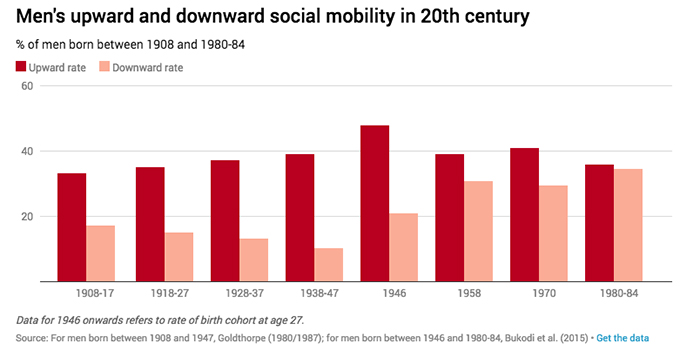
For two decades, social mobility has been a central concern in British politics. Increasing equality of opportunity, in the context of rising inequalities between people’s lives, has been a shared goal across the party political spectrum. Politicians have also agreed that educational policy is crucial to achieving this goal. This has made the thrust of speeches on social mobility given over the years by politicians including Tony Blair, Gordon Brown, David Cameron, Nick Clegg and Theresa May interchangeable.
Yet, new research I’ve published with my colleague John Goldthopre, which brings together results from extensive British birth cohort studies, points to a serious disconnect between the discussion of social mobility in political and policy circles and the findings of sociological research.
In our analysis, we treat social mobility in terms of social class, and make a clear distinction between absolute and relative mobility rates. Absolute rates simply refer to the proportions of individuals who have moved to different class positions to those of their parents, whether in an upward or downward direction. Relative rates compare the chances of individuals from different class origins ending up in a different class “destination”.
Contrary to what has become widely claimed in the media, mainly as a result of – often misunderstood – research by economists, social mobility in Britain is not in decline.
Absolute rates of class mobility between generations have been stable at least over the period since World War II. Men and women today are just as likely to be found in different class positions to those of their parents as they were in the 1950s.

The important change is, however, that rates of upward mobility are falling and rates of downward mobility are rising, as our research and the graph above shows. In this sense, young people now face less favourable mobility prospects than their parents or grandparents did. This is the result of the slowdown in the steady growth of managerial and professional employment that drove increasing upward mobility in the “golden age” from the 1950s up to the 1980s.
Relative rates of social mobility are also essentially stable: the inherent “stickiness” between the class positions of parents and children has altered little over at least the last half century. And in the case of “long-range” mobility – between, say, the lower stratum of the working class and those in managerial and professional jobs – quite extreme inequalities in relative chances exist.
Our findings show that the children of parents in higher managerial and professional positions are 20 times more likely to end up in such positions, rather than in working class positions, than children of working class parents are.
Not a low mobility society
Education plays an important role in determining whether a person is class mobile or immobile. But it does not follow that more education means more mobility at a societal level. For education to promote mobility at a societal level, the association between a person’s class origins and their educational attainment must weaken, while the association between their educational attainment and their class destinations must strengthen. But as our research shows, neither of these changes is in fact apparent. And that’s especially the case if education is considered in relative terms: for example if account is taken of the fact that a degree is worth far more in the labour market if only 10% of a birth cohort have one than if 40% do.
Again, contrary to what is widely claimed in the reports such as those by the Social Mobility Commission, Britain is not a distinctively low mobility society. Across European countries, rates of absolute class mobility are very similar. And as regards relative rates, Britain is one of a group of West-Nordic countries that show – comparatively – high fluidity within their class structures.
One reason for this is that, in Britain, education is not class destiny to the same extent as it is in a country such as Germany. In Germany, and several other Western-Central European countries, the educational system is highly stratified, with early selection for different types of school. Because there is then a tight link between formal educational qualifications and employment opportunities, educational inequalities are rather systematically translated into labour market inequalities. Where such “credentialism” prevails, education can in fact prove a barrier to, as much as a source of, social mobility.
No great leveller
Education is not “the great leveller” that can break the link between inequality in the conditions under which people live and inequality of opportunity. Parents with superior resources – economic, as well as social and cultural ones – will use their resources as necessary to give their children a competitive edge. Those wealthy enough can resort to the private sector, but for others the “commercialisation of opportunity” occurs by buying houses in the catchment areas of high-performing state schools, engaging private tutors for their children, and providing them with extensive out-of-school activities and experiences designed to improve their academic performance.
In addition, further education, or lifelong learning, turns out to promote immobility rather than mobility. As my research shows, it mainly gives “second chances” to those from more advantaged backgrounds whose performance in mainstream education gave them insufficient assurance that they would be able to maintain their parents’ position. It primarily serves to prevent downward mobility.
So far as absolute mobility is concerned, the most effective way of increasing upward mobility would be through economic and social policies that could renew the expansion of managerial and professional employment, so as to bring back the conditions of the golden age. One way of equalising relative rates of social mobility would be for employers to develop internal promotion and training policies to take full advantage of the educationally “wasted talent” that exists among their workforces and to remove requirements for formal qualifications of an irrelevant kind.
But in all societies with a capitalist market economy, a conjugal family system and liberal-democratic policies, a limit may exist on the extent that mobility chances can be equalised. As this limit is approached, policies aimed at further equalisation will become increasingly contested, and social mobility will cease to be a matter on which political consensus prevails.
Author Bio: Erzsebet Bukodi is an Associate Professor in Quantitative Social Policy at the University of Oxford
